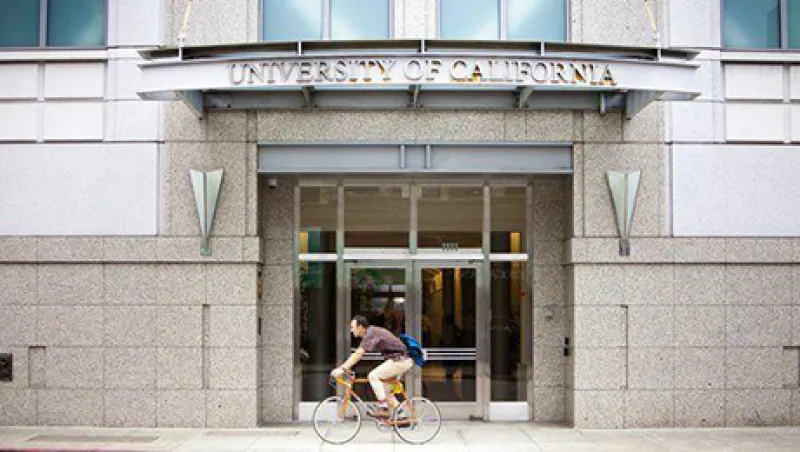As a journalist with (gulp) 15 years covering institutional asset management, I felt as if I knew a thing or two about how institutional investors think and operate. Recently, however, I got to learn a lot more. I was given the opportunity to take a three-month sabbatical from Institutional Investor magazine for a fellowship with the University of California, working in the San Francisco Bay Area. It was a true education — and not just because I got to see the San Francisco tech boom up close.
My fellowship was in the office of the chief investment officer for the University of California Board of Regents, reporting directly to CIO Jagdeep Singh Bachher and working with head of sustainability Amy Myers Jaffe, who is a professor at the University of California at Davis, an expert in energy policy — and a former reporter.
Based in Oakland, the office of the CIO oversees approximately $90 billion, mostly in pension and endowment assets. My overall assignment for the UC or UCOP (for the University of California Office of the President) was to study the integration of so-called ESG, which is the consideration of environmental, social and corporate governance factors, into investing across the industry. But my assignment also allowed me to come away with some general impressions. In some ways my experience at UCOP confirmed what I already knew — or thought I knew — about asset management. Some things surprised me, and others caused me to change my thinking. Here are six of my top takeaways:
1. Everyone wants to sell you something. Intuitively, I knew this. My first job with our parent company, Euromoney Institutional Investor, was working for what was then called Money Management Letter (now Money Management Intelligence ). We tracked searches (or would-be searches) for managers by pension funds and other institutional asset owners. Our readers were marketers and money managers looking to sell to these plans. It was a big day in the office, say, if the California Public Employees’ Retirement System announced it was looking for large-cap growth managers.
Why would CalPERS talk to me, a reporter who, at the time, knew next to nothing about asset management? Because it was easier to get the message out once via a publication than to field a million incoming calls from marketers. Still, once an investor said it was interested in, say, hedge funds, it would be fielding calls from hedge funds. If an organization says it is interested in stainability and ESG, as UCOP did a little over two years ago, it could expect to be inundated by ESG vendors.
I respect the work good marketers do and the value they can add. That is one of the reasons we include business development people in our Hedge Fund Rising Stars list every year. The UC and other public investors in California and in other states around country have in place strict rules, to which, in my experience, staff adhere diligently, in order to prevent pay-to-play.
Inundated with the noise of selling, however, it is hard to find true, valuable intelligence. For institutional investors that want to understand sustainable investing, for example, it is very hard for them to do that if everyone with whom they chat wants to sell them something. That is why peer networks become so important, and why I believe media outlets like Institutional Investor can add value.
2. To paraphrase Mike Tyson, everyone has a plan — until they get punched in the mouth. What I had failed to appreciate was how much the macroeconomic environment, as well as the politics of any institution, influences day-to-day operations within an investment office. A consequence is that big, long-term plans can get put on hold or take longer to execute because of the need to manage the here and now. The markets, particularly in this current climate of economic and political uncertainty, are a punch in the mouth every day.
3. ESG is here to stay. I truly believe that the consideration of so-called nonfinancial factors, such as climate change and economic inequality in investing, is a massive trend that is only going to get stronger as the data improve and more investors start taking notice. Today investors representing $60 trillion in assets have signed the Principles for Responsible Investing. Even when taking into consideration that some of that may be double counting and the like, that is up from zero dollars ten years ago, when the agreement was crafted with the support of the United Nations. The PRI asks that investors incorporate ESG factors into their investment decision making, and signatories also pledge to encourage other fund managers and asset owners to do the same.
There is a growing body of evidence to suggest that ESG factors do, in fact, have a meaningful financial impact on the long-term value of companies. There are also an increasing number of ESG-related investment opportunities, particularly around the green economy. The growing acceptance of ESG and sustainable investing is evident in the rate at which large asset management firms such as Goldman Sachs Asset Management and BlackRock have been building up their ESG businesses in recent years. That will happen more as a growing body of institutional investors sign onto the PRI or similar initiatives, and individual investors and stakeholders — such as pension beneficiaries and students — demand alignment between investment activities and values. The next shoe is already dropping in the 401(k) market.
Yet despite all of this activity, we remain a long way from understanding how to truly integrate ESG into investing and across all asset classes. UCOP is one among a handful of leading organizations that are seriously tackling the problem, and there is much more that can be done.
4. Fees matter — a lot. As a hedge fund reporter, which I was for many years, I used to think that fees did not matter that much. I thought net returns were far more important than how much an investor was paying. Hedge funds, as was the prevailing view before 2008, were worth it. A few things have happened over the past decade to change that. At UCOP I realized just how seriously investors are looking at fees and seeking to change the dynamic of the asset management industry, giving more authority back to the investors themselves.
The sheer amount of money going into hedge funds, especially from public pension plans and sovereign wealth funds, has resulted in a massive wealth transfer to the lucky few. In February hedge fund manager Ken Griffin paid $500 million for two paintings. It is legitimate to ask if it is right that someone makes that much money from asset management, especially when a significant portion of the money being managed belongs to public workers or not-for-profit institutions like universities.
The fee problem is not unique to hedge funds. Other managers can be equally guilty. And institutional investors still do — and should — pay for alpha. The problem in hedge funds, however, has been particularly acute because of the business model, the overall asset growth and the fact that, as a group, hedge funds have not performed well in recent years.
This all comes at the same time that the asset management industry is experiencing pressure over fees, both from investors and technology, which threatens to compress margins. Meanwhile, organizations like UCOP are taking on more agency, seeking to do more investing themselves and better leverage their own bank balance. Since assets are going to be increasingly held less at arm’s length, with investors exercising their rights as owners, this trend is a further reason to believe in the rise of ESG.
5. All hail the back office. We at II don’t write very much about the back office, but one thing that was clear to me was just how important the “plumbing” is to the overall investment process. At UCOP, I was surprised by how much time, people and resources are dedicated to this extremely important and critical function. I’m not going so far to say I want to start writing our global custody and services section any time soon, but I do have a newfound respect.
6. Ashby Monk is awesome. My second week at UCOP, I was sitting in a meeting that was about to start, and in walks Ashby Monk. “I know you,” he said, surprised to see me there. In my haste to prepare for the fellowship — moving across the country, finding an apartment, booking flights, getting my boyfriend to agree to a three-month move, preparing the dog — I had forgotten to tell II columnist and man-of-many-talents Monk that I’d be working at UCOP for a few months.
Monk, executive and research director of the Stanford Global Projects Center at Stanford University, just south of Oakland, has worked together with Bachher to create the Aligned Intermediary, an innovation involving the White House and other stakeholders aimed at getting investment capital into green energy infrastructure. The Aligned Intermediary is a great example of the type of innovation that Bachher is bringing to UCOP, leveraging the resources of the university and the San Francisco Bay Area for the benefit of his investment team and the UCOP funds. It is a tactic other institutions, particularly universities, which have such a wealth of resources to tap, could benefit from.
I want to thank UCOP — and Bachher in particular — for taking this leap of faith and opening up its doors to a journalist, even one on sabbatical. It was an invaluable experience and one I truly appreciate. Also, of course, I need to thank II and Editor Mike Peltz for allowing me to escape the New York winter and spend these three months out of the office.
At least I made it back in time to work on our Hedge Fund Industry Awards.
Follow Imogen Rose-Smith on Twitter at @imogennyc.
Get more on endowments.






